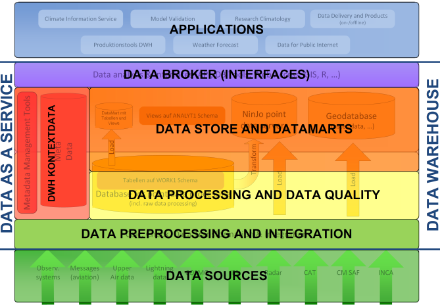Service Navigation
Search
As the national weather service, MeteoSwiss is entrusted with the recording, storage and management of wide-ranging meteorological and climatological data. Ground-based stations, weather radars and numerous other sources provide millions of measurement values in various formats each and every day. In order to manage this wealth of data, MeteoSwiss operates a data warehouse system. This includes a central database known as the data warehouse (DWH). The system also has a central metadata repository which contains all information on the description of the actual measured values and the management of the respective processes. The system also provides the tools for the preparation and processing (aggregation, quality assurance and amendment) of meteorological and climatological data as well as various other applications.
Customised data access
The DWH system provides quick, customised data access, both to current data and historical data series. MeteoSwiss produces the majority of its meteorological and climatological products – from its weather forecasts to its detailed climate analyses – using data from the DWH. External users can also access the data.
These measurement data are also available to external users via a variety of purchasing options. Please contact Customer Service for more information.
Architecture of the data warehouse system
The data warehouse is made up of a four-layer architecture:
- Data origin level: Data from a large number of sources is integrated into the system, i.e. fed in and stored systematically. The data range from ground-based measurement data and aviation weather reports to atmospheric data and model data.
- Data processing layer: The data processing involves calculations, follow-up processing and the amendment of errors.
- Data storage layer: The data are stored in a standardised form, meaning that they can be accessed quickly for all applications. For specific applications, selected data sets can be accessed in "data marts".
- Data analysis layer: The processed data can be consulted and analysed in a manner customised for different users and customers.
